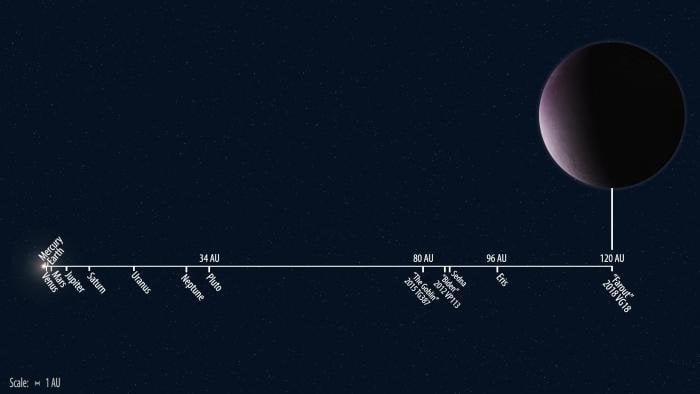Have you ever wondered if is there any planet beyond our solar system as we know it? There were indications of the existence of the mysterious Planet X, located at the very edge of our solar system, although that has never been confirmed for sure. Now, researchers have succeeded in observing what they think is the most distant object in our solar system, located at about 100 times farther than the distance that the Earth is from the Sun.
Researchers at the International Astronomical Union’s Minor Planet Center announced their discovery on Monday, Dec. 17, 2018, and the discovery was made by Carnegie’s Scott S. Sheppard, the University of Hawaii’s David Tholen and Northern Arizona University’s Chad Trujillo.
Scientists nicknamed the newly discovered 2018 VG18 “Farout” because of its location, currently being the most distant object in our solar system, known so far. It is located at roughly 120 astronomical units (AU), with 1 AU measured as the distance between the Earth and the Sun.
The planet was discovered as part of the efforts of scientists to search extremely distant objects in the solar system, which also includes the aforementioned Planet X, also called Planet 9. Earlier in October of this year, the same team of researchers discovered another planet from our Solar System, called 2015 TG387, which is also known as “The Goblin” – this spooky nickname comes from the fact October is often referred to as the “Halloween” month.
The location of the Goblin is at about 80 AU, which is significantly closer to the sun than the newly discovered most distant object in our solar system. It was proposed back then, that the orbit, rotation and revolution around the Sun of this planet is influenced by the mysterious Planet X, which is believed to be super-Earth-sized.
Scientists don’t know much about 2018 VG18’s orbit yet, at least not enough to confirm its orbit is being influenced by Planet X.
“2018 VG18 is much more distant and slower moving than any other observed Solar System object, so it will take a few years to fully determine its orbit,” Sheppard said in a statement. “But it was found in a similar location on the sky to the other known extreme Solar System objects, suggesting it might have the same type of orbit that most of them do. The orbital similarities shown by many of the known small, distant Solar System bodies was the catalyst for our original assertion that there is a distant, massive planet at several hundred AU shepherding these smaller objects.”
The first images of 2018 VG18 were taken by the Japanese Subaru 8-meter telescope which is located in Hawaii. The images were taken on Nov. 10. However, they needed to confirm the planet’s existence so they had to spend multiple nights with the telescope to catch a glimpse of the planet. The second time they saw the planet was in early December, using the Magellan telescope at Carnegie’s Las Campanas Observatory in Chile. They observed it with the same telescope for some time, until they confirmed some of its physical properties.
The new observations showed that the most distant object in our solar system as of now is located at about 120 AU, which is the first object in our solar system observed at more than 100 AU. Its brightness helped the team determine that it is probably about 310 miles in diameter and that it is likely a dwarf planet.





